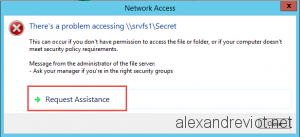Sometimes, it can be usefull to disable access to the Exchange server for a specific mailbox. For exemple, in order to forbid Outlook Web App (Outlook on the Web for Exchange 2016) but you do not want to disable the user account. Or you can prestage the mailbox and only allow access to a specific date/ time.
This can also be used during a migration to another mail system: when the user is migrated, you can disable all access to force the user on the new messaging system. And prevent any email sent by the old Exchange.
Let’s see how to disable all access for a mailbox using ECP or Exchange Powershell:




